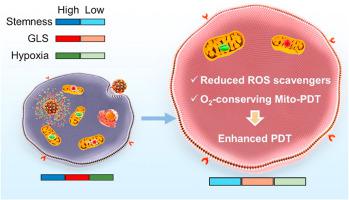当前位置:
X-MOL 学术
›
Biomaterials
›
论文详情
Our official English website, www.x-mol.net, welcomes your feedback! (Note: you will need to create a separate account there.)
Glutaminolysis inhibition boosts photodynamic therapy to eliminate cancer stem cells
Biomaterials ( IF 14.0 ) Pub Date : 2024-02-02 , DOI: 10.1016/j.biomaterials.2024.122497 Qiang Wang , Shiyou Li , Chen Xu , Xing Wang , Tian Yang , Chong Wang , Yuxuan Xiong , Zhijie Zhang , Xiangliang Yang , Zifu Li
Biomaterials ( IF 14.0 ) Pub Date : 2024-02-02 , DOI: 10.1016/j.biomaterials.2024.122497 Qiang Wang , Shiyou Li , Chen Xu , Xing Wang , Tian Yang , Chong Wang , Yuxuan Xiong , Zhijie Zhang , Xiangliang Yang , Zifu Li

|
High reactive oxygen species (ROS) levels provide a therapeutic opportunity to eradicate cancer stem cells (CSCs), a population of cells responsible for tumorigenesis, progression, metastasis, and recurrence. However, enhanced antioxidant systems in this population of cells attenuate ROS-inducing therapies. Here, we developed a nanoparticle-assisted combination therapy to eliminate CSCs by employing photodynamic therapy (PDT) to yield ROS while disrupting ROS defense with glutaminolysis inhibition. Specifically, we leveraged an oleic acid-hemicyanine conjugate (CyOA) as photosensitizer, a new entity molecule HYL001 as glutaminolysis inhibitor, and a biocompatible folic acid-hydroxyethyl starch conjugate (FA-HES) as amphiphilic surfactant to construct cellular and mitochondrial hierarchical targeting nanomedicine (COHF NPs). COHF NPs inhibited glutaminolysis to reduce intracellular ROS scavengers, including glutathione (GSH) and nicotinamide adenine dinucleotide phosphate (NADPH), and to blunt oxidative phosphorylation (OXPHOS) for oxygen-conserved PDT. Compared to COLF NPs without glutaminolysis inhibitor, COHF NPs exhibited higher phototoxicity to breast cancer stem cells (BCSCs) both and . More importantly, we corroborated that marketed glutaminolysis inhibitors, such as CB839 and V9302, augment the clinically used photosensitizer (Hiporfin) for BCSCs elimination. This study develops a potent CSCs targeting strategy by combining glutaminolysis inhibition with PDT and provides significant implications for cancer therapy.
中文翻译:

谷氨酰胺分解抑制促进光动力疗法消除癌症干细胞
高活性氧 (ROS) 水平提供了根除癌症干细胞 (CSC) 的治疗机会,癌症干细胞是负责肿瘤发生、进展、转移和复发的细胞群。然而,该细胞群中增强的抗氧化系统会减弱 ROS 诱导疗法。在这里,我们开发了一种纳米颗粒辅助联合疗法,通过采用光动力疗法(PDT)产生ROS,同时通过谷氨酰胺分解抑制破坏ROS防御来消除CSC。具体来说,我们利用油酸-半花青缀合物(CyOA)作为光敏剂,新的实体分子HYL001作为谷氨酰胺分解抑制剂,以及生物相容性叶酸-羟乙基淀粉缀合物(FA-HES)作为两亲表面活性剂,构建了细胞和线粒体分层靶向纳米药物(COHF 纳米粒子)。COHF NP 抑制谷氨酰胺分解,减少细胞内 ROS 清除剂,包括谷胱甘肽 (GSH) 和烟酰胺腺嘌呤二核苷酸磷酸 (NADPH),并减弱氧守恒 PDT 的氧化磷酸化 (OXPHOS)。与不含谷氨酰胺分解抑制剂的COLF NPs相比,COHF NPs对乳腺癌干细胞(BCSCs)表现出更高的光毒性。更重要的是,我们证实市售的谷氨酰胺分解抑制剂(例如 CB839 和 V9302)可增强临床使用的光敏剂 (Hiporfin) 消除 BCSC 的效果。这项研究通过将谷氨酰胺分解抑制与 PDT 相结合,开发了一种有效的 CSC 靶向策略,并为癌症治疗提供了重要意义。
更新日期:2024-02-02
中文翻译:

谷氨酰胺分解抑制促进光动力疗法消除癌症干细胞
高活性氧 (ROS) 水平提供了根除癌症干细胞 (CSC) 的治疗机会,癌症干细胞是负责肿瘤发生、进展、转移和复发的细胞群。然而,该细胞群中增强的抗氧化系统会减弱 ROS 诱导疗法。在这里,我们开发了一种纳米颗粒辅助联合疗法,通过采用光动力疗法(PDT)产生ROS,同时通过谷氨酰胺分解抑制破坏ROS防御来消除CSC。具体来说,我们利用油酸-半花青缀合物(CyOA)作为光敏剂,新的实体分子HYL001作为谷氨酰胺分解抑制剂,以及生物相容性叶酸-羟乙基淀粉缀合物(FA-HES)作为两亲表面活性剂,构建了细胞和线粒体分层靶向纳米药物(COHF 纳米粒子)。COHF NP 抑制谷氨酰胺分解,减少细胞内 ROS 清除剂,包括谷胱甘肽 (GSH) 和烟酰胺腺嘌呤二核苷酸磷酸 (NADPH),并减弱氧守恒 PDT 的氧化磷酸化 (OXPHOS)。与不含谷氨酰胺分解抑制剂的COLF NPs相比,COHF NPs对乳腺癌干细胞(BCSCs)表现出更高的光毒性。更重要的是,我们证实市售的谷氨酰胺分解抑制剂(例如 CB839 和 V9302)可增强临床使用的光敏剂 (Hiporfin) 消除 BCSC 的效果。这项研究通过将谷氨酰胺分解抑制与 PDT 相结合,开发了一种有效的 CSC 靶向策略,并为癌症治疗提供了重要意义。



























 京公网安备 11010802027423号
京公网安备 11010802027423号